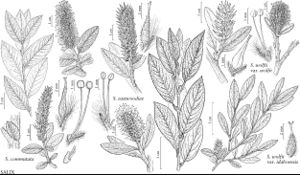Salix commutata
Bot. Gaz. 13: 110. 1888.
Plants 0.2–3 m. Stems: branches yellowbrown, gray-brown, or redbrown, not or weakly glaucous, pilose; branchlets yellow-green, yellowbrown, or redbrown, pilose to densely villous or woolly. Leaves: stipules (sometimes marcescent), foliaceous, apex rounded or acute; petiole shallowly grooved or convex to flat adaxially, 1.5–11 mm, pilose or tomentose adaxially; largest medial blade (sometimes amphistomatous), narrowly oblong, oblong, elliptic, or broadly elliptic, 10–100 × 5–44 mm, 1.5–3.4 times as long as wide, base convex, rounded, subcordate, or cordate, margins flat or slightly revolute, entire or serrulate, apex acuminate, acute, or convex, abaxial surface not glaucous, moderately densely tomentose, villous, or pilose to glabrescent, hairs wavy or straight, adaxial dull or slightly glossy, pilose or moderately densely villous to glabrescent; proximal blade margins entire or shallowly serrulate; juvenile blade yellowish green, sparsely to densely long-silky-tomentose abaxially, hairs white. Catkins flowering as leaves emerge; staminate stout or subglobose, 15–37 × 8–20 mm, flowering branchlet 2–33 mm; pistillate densely or moderately densely flowered, slender, stout, or subglobose, 17–60 × 7–15 mm, flowering branchlet 3–15 (–30) mm; floral bract tawny, brown, or bicolor, 1–3 mm, apex acute or rounded, abaxially hairy, hairs straight or wavy. Staminate flowers: adaxial nectary oblong or square, 0.2–0.8 mm; filaments distinct, glabrous; anthers yellow or purple turning yellow, 0.4–1 mm. Pistillate flowers: adaxial nectary oblong, square, or ovate, 0.3–0.7 mm, shorter than stipe; stipe 0.3–2 mm; ovary pyriform or obclavate, glabrous, beak gradually to abruptly tapering to styles; ovules 10–28 per ovary; styles 0.5–1.5 mm; stigmas flat, abaxially non-papillate with rounded tip, broadly cylindrical, or 2 plump lobes, 0.16–0.34–0.4 mm. Capsules 3.5–8 mm. 2n = 38.
Phenology: Flowering late May-mid Aug.
Habitat: Rocky alpine and subalpine slopes, glacial moraine, open spruce woods, streamsides, gravel benches along streams, wet fens
Elevation: 0-2400 m
Distribution

Alta., B.C., N.W.T., Sask., Yukon, Alaska, Idaho, Mont., Oreg., Wash.
Discussion
The rare occurrence in Salix commutata of plants with ovary indumentum composed of divergent, straight or wavy, flattened hairs may be hybrids with 53. S. eastwoodiae (see for discussion and comparison).
Hybrids:
Salix commutata forms natural hybrids with S. barclayi, S. barrattiana, and S. eastwoodiae.
Selected References
None.
Lower Taxa
"-0.4mm" is not declared as a valid unit of measurement for this property.
